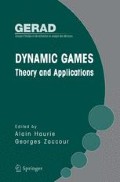Abstract
This note considers production (or market) games with transferable utility. It brings out that, in many cases, explicit core solutions may be defined by shadow prices — and reached via quite natural dynamics.
Access this chapter
Tax calculation will be finalised at checkout
Purchases are for personal use only
Preview
Unable to display preview. Download preview PDF.
References
Aubin, J-P. (1991). Viability Theory. Birkhäuser, Boston.
Benveniste, A., Métivier, M., and Priouret, P. (1990). Adaptive Algorithms and Stochastic Approximations. Springer, Berlin.
Bourass, A. and Giner, E. (2001). Kuhn-Tucker conditions and integral functionals. Journal of Convex Analysis 8,2, 533–553 (2001).
Dubey, P. and Shapley, L.S. (1984). Totally balanced games arising from controlled programming problems. Mathematical Programming, 29:245–276.
Ellickson, B. (1993). Competitive Equilibrium. Cambridge University Press.
Evstigneev, I.V. and Flåm, S.D. (2001). Sharing nonconvex cost. Journal of Global Optimization, 20:257–271.
Flåm, S.D. (2002). Stochastic programming, cooperation, and risk exchange. Optimization Methods and Software, 17:493–504.
Flåm, S.D., and Jourani, A. (2003). Strategic behavior and partial cost sharing. Games and Economic Behavior, 43:44–56.
Forgó, F., Szép, J., and Szidarovszky, F. (1999). Introduction to the Theory of Games. Kluwer Academic Publishers, Dordrecht.
Gintis, H. (2000). Game Theory Evolving. Princeton University Press.
Gomory, R.E. and Baumol, W.J. (1960). Integer programming and pricing. Econometrica, 28(3):521–550.
Granot, D. (1986). A generalized linear production model: A unifying model. Mathematical Programming, 43:212–222.
Kalai, E. and Zemel, E. (1982). Generalized network problems yielding totally balanced games. Operations Research, 30(5):998–1008.
Mas-Colell, A., Whinston, M.D., and Green, J.R. (1995). Microeconomic Theory. Oxford University Press.
Owen, G. (1975). On the core of linear production games. Mathematical Programming, 9:358–370.
Peyton Young, H. (1994). Equity. Princeton University Press.
Samet, D. and Zemel, S. (1994). On the core and dual set of linear programming games. Mathematics of Operations Research, 9(2):309–316.
Sandsmark, M. (1999). Production games under uncertainty. Computational Economics, 3:237–253.
Scarf, H.E. (1990). Mathematical programming and economic theory. Operations Research, 38:377–385.
Scarf, H.E. (1994). The allocation of resources in the presence of indivisibilities. Journal of Economic Perspectives, 8(4):111–128.
Shapley, L.S. (1967). On balanced sets and cores. Naval Research Logistics Quarterly, 14:453–461.
Shapley, L.S. and Shubik, M. (1969). On market games. Journal of Economic Theory, 1:9–25.
Verga-Redondo, F. (2003). Economics and the Theory of Games. Cambridge University Press.
Wolsey, L.A. (1981). Integer programming duality: Price functions and sensitivity analysis. Mathematical Programming, 20:173–195.
Editor information
Editors and Affiliations
Rights and permissions
Copyright information
© 2005 Springer Science+Business Media, Inc.
About this chapter
Cite this chapter
Flåm, S.D. (2005). Production Games and Price Dynamics. In: Haurie, A., Zaccour, G. (eds) Dynamic Games: Theory and Applications. Springer, Boston, MA. https://doi.org/10.1007/0-387-24602-9_4
Download citation
DOI: https://doi.org/10.1007/0-387-24602-9_4
Publisher Name: Springer, Boston, MA
Print ISBN: 978-0-387-24601-7
Online ISBN: 978-0-387-24602-4
eBook Packages: Business and EconomicsEconomics and Finance (R0)

